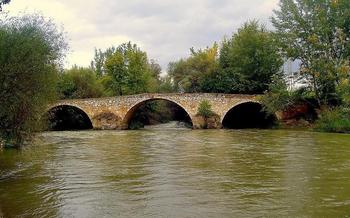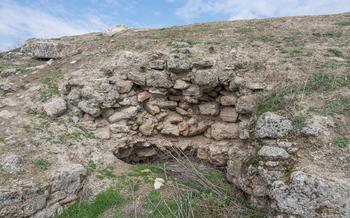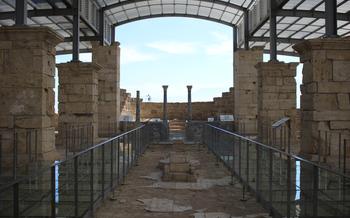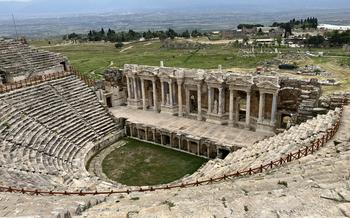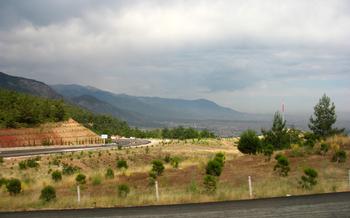
Laodicea on the Lycus
- Laodicea on the Lycus: A Journey Through Time
- Exploring the Ruins of Laodicea
- The Laodicean Church: A Symbol of Faith
- The Lycus River: A Vital Waterway
- The Laodicean Thermal Springs: A Natural Wonder
- The Laodicean Theater: A Stage for Drama and Spectacle
- The Laodicean Stadium: A Place of Contests and Triumphs
- The Laodicean Nymphaeum: A Sanctuary for Water Nymphs
- The Laodicean Agora: A Bustling Marketplace
- The Laodicean Odeon: A Smaller Venue for Performances
- The Laodicean Acropolis: A Fortified Citadel
- The Laodicean Tombs: A Glimpse into the Afterlife
- The Laodicean Museum: A Treasure Trove of Artifacts
- Insider Tip: Off-the-Beaten-Path Gems
Laodicea on the Lycus: A Journey Through Time
Laodicea on the Lycus, an ancient city in southwestern Turkey, invites you on a captivating journey through history. Founded in the 3rd century BC by the Seleucid king Antiochus II Theos, Laodicea flourished as a major trading center on the Lycus River. Its strategic location at the crossroads of important trade routes made it a wealthy and influential city in the ancient world.
Laodicea's ruins, situated near the modern city of Denizli, offer a glimpse into the grandeur of its past. The city's impressive remains include a well-preserved theater, a stadium, a nymphaeum, and the remains of several temples and churches. Laodicea's rich history, combined with its stunning natural surroundings, makes it a must-visit destination for anyone interested in ancient history and archaeology.
The best time to visit Laodicea is during the shoulder seasons (spring and autumn) when the weather is pleasant and the crowds are smaller. Remember to wear comfortable shoes as you'll be doing a lot of walking on uneven surfaces. Also, bring plenty of water and sunscreen, as there's limited shade at the site.
To reach Laodicea, you can take a bus or rent a car from Denizli. The journey takes about 30 minutes. Once you arrive, you can purchase a ticket at the entrance gate and explore the ruins at your own pace or with a guided tour.
Exploring the Ruins of Laodicea
Laodicea's ancient ruins, frozen in time, offer a tangible connection to the city's glorious past. Stroll along the colonnaded streets, marveling at the well-preserved remains of temples, public buildings, and opulent residences. The city's layout, remarkably intact, showcases the urban planning skills of the ancient Greeks.
Among the must-see ruins is the impressive stadium, a testament to Laodicea's sporting prowess. Imagine the roar of the crowd as athletes competed in footraces, wrestling matches, and chariot races. The theater, with its superb acoustics and intricate carvings, hosted performances of Greek tragedies, comedies, and musical concerts.
Don't miss the nymphaeum, a sanctuary dedicated to water nymphs. Its exquisite carvings and cascading fountains create a serene and picturesque setting. The nymphaeum served as a vital water source for the city and held religious significance for the Laodiceans.
Navigating the site is relatively easy, thanks to well-marked paths and informative signboards. However, wearing comfortable shoes is essential, as the terrain can be uneven and dusty. A hat and sunscreen are also recommended, as shade is limited.
The Laodicean Church: A Symbol of Faith
The Laodicean Church stands as a testament to the deep-rooted Christian history of Laodicea. Originally constructed in the 4th to 5th centuries AD, this significant church played a vital role in spreading Christianity throughout the region. Today, visitors can explore the ruins of this ancient place of worship and gain insights into its enduring legacy.
The church's location within the city walls underscores its importance to the local community. Though partially destroyed by earthquakes and subsequent neglect, the remaining ruins still convey a sense of its grandeur. Visitors can admire the intricate carvings and architectural details that adorn the church's façade, offering a glimpse into its former glory.
Biblical references to the church in the Book of Revelation add to its significance. The church is mentioned in the letter to the Laodiceans, where it is described as neither hot nor cold, but lukewarm, leading to a powerful metaphor about the spiritual state of the congregation. This reference has sparked theological discussions and interpretations, making the church a subject of interest for scholars and pilgrims alike.
Archaeological discoveries at the site have further enriched our understanding of the church's history. Excavations have revealed well-preserved mosaics depicting biblical scenes and intricate geometric patterns, providing valuable insights into the artistic traditions of the early Christian community. These mosaics add a vibrant dimension to the ruins, bringing the past to life for modern visitors.
To make the most of your visit, plan to incorporate the Laodicean Church into your itinerary. Explore the ruins, marvel at the architectural details, and reflect on the spiritual significance of this ancient place of worship. Let the church's legacy transport you back in time, offering a glimpse into the vibrant Christian community that once thrived in Laodicea.
The Lycus River: A Vital Waterway
The Lycus River, also known as the Çürüksu River, was a lifeline for the ancient city of Laodicea. Flowing from the Honaz Mountains, the river provided a vital source of water for irrigation and drinking, as well as a means of transportation and trade. Along its scenic banks, visitors can witness the harmonious blend of natural beauty and historical significance.
Strolling along the riverbanks, one can't help but admire the lush vegetation that thrives thanks to the river's nourishing waters. The tranquil atmosphere invites relaxation and contemplation, as the gentle sound of the flowing water creates a soothing symphony. In the warm summer months, the river becomes a popular spot for locals and tourists alike, who flock to its shores to escape the heat and enjoy a refreshing dip in the cool waters.
For those seeking adventure, the Lycus River offers a range of exciting activities. Swimming, fishing, and boating are popular ways to experience the river's natural beauty. Anglers can try their luck at catching a variety of fish species that inhabit the river, while boaters can embark on a leisurely journey along its calm waters, taking in the sights of the ancient city and the surrounding countryside.
To fully appreciate the significance of the Lycus River, it's worth taking the time to explore its surroundings. Ancient ruins and historical landmarks dot the riverbanks, offering glimpses into the rich past of Laodicea. Visitors can marvel at the remains of ancient bridges, aqueducts, and watermills, which once played a crucial role in the city's infrastructure. These remnants of a bygone era stand as testaments to the ingenuity and resourcefulness of the Laodiceans, who harnessed the power of the Lycus River to fuel their civilization.
Whether you're seeking relaxation, adventure, or a glimpse into the past, the Lycus River offers a unique and unforgettable experience for visitors to Laodicea. Its scenic beauty, historical significance, and abundance of activities make it a must-visit destination for anyone exploring this ancient city.
The Laodicean Thermal Springs: A Natural Wonder
Laodicea on the Lycus was renowned for its thermal springs, which were believed to possess healing properties. These hot springs were a significant part of the city's culture and economy, attracting visitors from all over the region. The thermal baths were intricately designed to provide a luxurious and therapeutic experience. The Romans constructed impressive bathing facilities, including pools of varying temperatures, steam rooms, and massage rooms.
Today, visitors can still bathe in the thermal waters and experience their rejuvenating effects. The hot springs are located just a short walk from the ancient city, and several modern thermal baths have been built to accommodate tourists. Visitors can choose from a variety of bathing options, including private pools, communal baths, and spa treatments.
Ancient customs and rituals associated with the thermal springs continue to be practiced to this day. Visitors can participate in traditional bathing rituals, such as pouring water over their heads to receive blessings or making offerings to the water nymphs. These rituals provide a unique glimpse into the spiritual and cultural significance of the thermal springs in ancient times.
Tips for Enjoying a Relaxing Soak in the Thermal Waters:
- Plan Your Visit: Choose a time when the thermal baths are less crowded to fully enjoy the tranquil atmosphere.
- Bring Swimwear and Towels: Remember to pack appropriate swimwear and towels for your bathing experience.
- Stay Hydrated: Drink plenty of water before and after bathing to prevent dehydration.
- Respect the Customs: Be respectful of local customs and traditions when participating in bathing rituals.
- Indulge in a Massage: Enhance your experience with a relaxing massage or spa treatment at one of the thermal baths.
- Enjoy the Scenery: Take a moment to admire the stunning views of the surrounding countryside while you soak in the thermal waters.
The Laodicean Theater: A Stage for Drama and Spectacle
Amidst the ruins of Laodicea, the theater stands as a testament to the city's rich cultural heritage. Built in the 2nd century AD, this impressive structure could accommodate up to 15,000 spectators, making it one of the largest theaters in ancient Phrygia. Its well-preserved stage, orchestra, and seating tiers offer a glimpse into the world of ancient drama and entertainment.
The theater's architectural features are a testament to the skill of its builders. The stage is adorned with intricate carvings and sculptures, depicting scenes from mythology and history. The orchestra, where the chorus performed, is surrounded by a series of concentric seating tiers, rising steeply from the stage. The tiers are divided by vomitoria, or passageways, allowing for easy access and egress.
In ancient times, the theater was the venue for a variety of performances, including plays, concerts, and dance recitals. It also hosted gladiator contests and chariot races, which were popular forms of entertainment in the Roman world. The acoustics of the theater are remarkable, allowing the actors' voices to carry clearly to the furthest rows.
Today, the Laodicean Theater is undergoing a comprehensive restoration project, aimed at preserving this magnificent structure for future generations. Visitors can explore the theater, admire its architectural details, and imagine the excitement and spectacle that once filled this ancient stage.
Tips for catching a performance or exploring the theater:
- Check the local tourism office or website for information on upcoming performances.
- Arrive early to secure a good seat and avoid crowds.
- Bring a hat, sunscreen, and water, as the theater is mostly exposed to the sun.
- Wear comfortable shoes, as you will be doing a lot of walking on uneven surfaces.
- Be respectful of the ongoing restoration work and follow any instructions or guidelines provided by the site staff.
The Laodicean Stadium: A Place of Contests and Triumphs
Amidst the ruins of Laodicea on the Lycus, the ancient stadium stands as a testament to the city's sporting prowess and love of spectacle. Built in the 2nd century AD, this impressive structure could accommodate up to 15,000 spectators eager to witness a variety of thrilling events.
Measuring approximately 210 meters in length and 50 meters in width, the stadium's design mirrored those found in other major cities of the Roman Empire. Its elliptical shape ensured that spectators had an unobstructed view of the action unfolding in the arena below. Constructed using local limestone, the stadium's tiers of seating rose gracefully, supported by a series of vaulted arches.
In the arena, athletes competed in a range of sporting events, including footraces, wrestling, boxing, and chariot races. The stadium also hosted gladiatorial contests, where fierce warriors engaged in deadly combat for the entertainment of the bloodthirsty crowds. The roar of the spectators and the clash of weapons must have reverberated through the air, creating an atmosphere of intense excitement and danger.
Today, the stadium stands in ruins, its once-vibrant facade weathered by time and earthquakes. Yet, its imposing presence and the remnants of its seating tiers still evoke the grandeur and spectacle of ancient sporting events. Visitors can wander through the stadium, imagining the roar of the crowd and the triumphs of legendary athletes as they competed for glory and honor.
The Laodicean Nymphaeum: A Sanctuary for Water Nymphs
Amidst the bustling streets and impressive ruins of Laodicea, lies a hidden gem that embodies the essence of tranquility and beauty: the Laodicean Nymphaeum. Constructed as a sanctuary dedicated to the water nymphs, this exquisite structure served as a place of worship, relaxation, and social gatherings.
The nymphaeum's design is a testament to the Laodiceans' architectural prowess. Its facade is adorned with intricate carvings depicting mythological scenes, while the interior features a series of niches and alcoves, each housing a statue of a water nymph. The central feature of the nymphaeum is a large pool, surrounded by a colonnaded walkway. Water cascaded into the pool from a series of fountains, creating a soothing and melodic soundscape.
Beyond its aesthetic appeal, the nymphaeum held deep religious significance for the Laodiceans. Water was considered a sacred element, and the nymphs were believed to possess the power to grant fertility, healing, and protection. Devotees would come to the nymphaeum to pray to the nymphs, make offerings, and seek their blessings.
The nymphaeum was also a popular gathering place for the Laodiceans. Its serene atmosphere and refreshing waters provided a welcome respite from the hustle and bustle of city life. People would come here to socialize, relax, and enjoy the beauty of their surroundings.
Today, the Laodicean Nymphaeum stands as a testament to the ingenuity and artistry of the ancient Laodiceans. Its ruins, though weathered by time, still exude an aura of tranquility and beauty. Visitors can wander through the nymphaeum, marveling at its intricate carvings, and imagining the rituals and ceremonies that once took place within its walls.
The Laodicean Agora: A Bustling Marketplace
The Laodicean agora, the bustling heart of the ancient city, served as a central marketplace and a hub for economic and social activities. Located at the crossroads of major trade routes, the agora played a vital role in Laodicea's prosperity. Merchants from across the region gathered here to trade goods, barter their wares, and exchange news and ideas.
Strolling through the agora, visitors would encounter a vibrant tapestry of sights, sounds, and smells. The air buzzed with the hum of voices, the clatter of coins, and the cries of street vendors hawking their goods. Artisans displayed their wares, from intricately carved pottery and jewelry to fine textiles and exotic spices. Farmers brought their fresh produce, while merchants from distant lands showcased their imported goods.
In addition to its economic significance, the agora served as a social and cultural meeting place. Philosophers engaged in lively debates, while poets and musicians entertained the crowds. Public assemblies were held to discuss important matters, and festivals and celebrations brought the community together.
To fully appreciate the essence of the Laodicean agora, take a moment to close your eyes and imagine the vibrant atmosphere of this ancient marketplace. Picture the bustling crowds, the colorful stalls, and the sounds of commerce and conversation. Let your senses transport you back in time to the bustling heart of Laodicea.
The Laodicean Odeon: A Smaller Venue for Performances
In the heart of Laodicea, tucked between the bustling agora and the grand theater, lies the Laodicean Odeon, a smaller but equally captivating venue for performances. This intimate structure, with its graceful curves and elegant design, served as a stage for a variety of cultural and artistic expressions.
The odeon's primary purpose was to host musical performances, poetry recitals, and dramatic readings. Its acoustics were carefully engineered to ensure that the spoken word and musical notes resonated throughout the space, creating an immersive experience for the audience. The odeon also provided a more intimate setting for performances compared to the larger theater, allowing for a closer connection between performers and spectators.
Although smaller in size, the odeon boasts architectural features that rival those of its grander counterpart. Its well-preserved facade features intricate carvings and decorative elements, showcasing the craftsmanship and artistry of Laodicean builders. The interior is adorned with marble benches arranged in tiers, providing comfortable seating for hundreds of spectators.
Today, the Laodicean Odeon stands as a testament to the city's rich cultural heritage. While no longer hosting performances, it remains a popular attraction for visitors who can explore its well-preserved remains and imagine the vibrant atmosphere that once filled this space. Ongoing restoration efforts aim to preserve this architectural gem for future generations, ensuring that its legacy continues to inspire and captivate.
The Laodicean Acropolis: A Fortified Citadel
Perched atop a hill overlooking the ancient city, the Laodicean Acropolis served as a strategic stronghold and a symbol of power. Its massive walls, reinforced with towers and gates, provided a formidable defense against invaders. Within the acropolis, temples, administrative buildings, and residences for officials and soldiers created a self-sufficient community.
Explore the ruins of the acropolis to discover the remains of these structures and imagine the bustling activity that once took place here. Admire the architectural details, such as the finely carved stonework and intricate mosaics, that adorned the buildings. From the acropolis, you'll be rewarded with panoramic views of the surrounding countryside, offering a glimpse into the vastness of the ancient Laodicean territory.
Tips for Exploring the Acropolis:
- Wear comfortable shoes for walking on uneven terrain.
- Bring water and sunscreen, as there is limited shade within the acropolis.
- Be mindful of your surroundings and avoid climbing on unstable structures.
- Visit early in the morning or late in the afternoon to avoid the midday heat.
- Combine your visit to the acropolis with a tour of the other ancient ruins in Laodicea for a comprehensive experience.
The Laodicean Tombs: A Glimpse into the Afterlife
Laodicea's diverse collection of tombs offers a unique glimpse into the city's funerary customs and beliefs about the afterlife. From simple rock-cut graves to elaborate mausoleums, these tombs showcase a variety of architectural styles and decorative elements. Some tombs feature intricate carvings and inscriptions that provide insights into the lives and legacies of the deceased.
One of the most impressive tombs is the Tomb of Sextus Varius Marcellus, a wealthy Roman official. This grand mausoleum features a Doric portico, a barrel-vaulted interior, and a large burial chamber. The tomb is adorned with exquisite sculptures and reliefs depicting scenes from Greek mythology and Roman history.
Another notable tomb is the Tomb of the Gladiators, which contains the remains of several gladiators who died in the city's arena. The tomb features a series of niches where the gladiators' ashes were placed, along with inscriptions commemorating their victories and defeats.
Exploring the Laodicean tombs is a fascinating way to learn about the city's past and the beliefs of its people. Visitors can wander among the ruins, admire the intricate carvings, and imagine the lives of those who were laid to rest here centuries ago.
Tips for exploring the Laodicean tombs:
-
Be respectful of the dead. These tombs are the final resting places of real people, so it is important to be respectful and avoid disturbing the peace.
-
Wear comfortable shoes. The tombs are often located on uneven terrain, so it is important to wear sturdy shoes that will protect your feet.
-
Bring water and sun protection. The tombs are mostly exposed to the elements, so it is important to bring water and sun protection to stay hydrated and cool.
-
Take your time. There is a lot to see and learn at the Laodicean tombs, so take your time exploring and take in the details.
The Laodicean Museum: A Treasure Trove of Artifacts
Discover the Hidden Treasures of Laodicea
Step into the Laodicean Museum, a treasure trove of artifacts that unveils the rich history and vibrant culture of this ancient city. Immerse yourself in the captivating exhibits, where stories come alive through exquisite sculptures, finely crafted pottery, and gleaming coins.
Among the museum's highlights, marvel at the intricate carvings that adorn the marble statues, capturing the essence of Laodicean artistry. Admire the delicate pottery, each piece a testament to the skill and creativity of local craftsmen. Delve into the history of Laodicea through its coinage, with each coin bearing witness to the city's economic and political significance.
The museum also boasts temporary exhibits that showcase the latest archaeological discoveries and shed light on specific aspects of Laodicean life. Engage in educational programs that bring history to life, offering a deeper understanding of the ancient world.
Tips for a Rewarding Visit:
- Plan your visit to coincide with a temporary exhibit to experience a fresh perspective on Laodicean culture.
- Take advantage of the museum's guided tours to gain insights from knowledgeable experts.
- Capture the beauty of the artifacts through photography, but be mindful of any restrictions.
- Respect the museum's rules and regulations to ensure the preservation of these precious artifacts for generations to come.
Insider Tip: Off-the-Beaten-Path Gems
Beyond the main attractions, Laodicea holds hidden corners and lesser-known sites that offer a glimpse into the city's rich history and culture. For those willing to venture off the beaten path, here are some insider tips:
-
Explore the Byzantine Church of St. George: Located a short walk from the ancient city, this well-preserved church features stunning frescoes and architectural details that transport visitors back in time.
-
Discover the Laodicean Aqueduct: Follow the remnants of this ancient aqueduct, which once brought fresh water to the city from distant springs. The aqueduct offers scenic views of the surrounding countryside.
-
Visit the Laodicean Necropolis: Venture beyond the city walls to explore the vast necropolis, where elaborate tombs and sarcophagi provide insights into Laodicean burial customs.
-
Hike to the Laodicean Caves: For adventurous travelers, a hike to the nearby caves offers breathtaking views of the city and the surrounding mountains. The caves also hold archaeological significance, with evidence of human habitation dating back to prehistoric times.
-
Stroll Along the Lycus River: Take a leisurely walk along the banks of the Lycus River, enjoying the serene scenery and spotting local wildlife. The riverbanks offer tranquil spots for picnics and relaxation.
These hidden gems provide a unique opportunity to experience the lesser-known aspects of Laodicea and create lasting memories of your journey through this ancient city.

